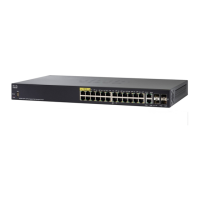Route Map Commands
Cisco Sx350 Ph. 2.2.5 Devices - Command Line Interface Reference Guide 1036
53
Parameters
•
map-tag
—A meaningful name for the route map. The redistribute router
configuration command uses this name to reference this route map. Multiple
route maps may share the same map tag name.
•
sequence-number
—Positive integer number that indicates the position a
new route map will have in the list of route maps already configured with the
same name. If the parameter is used with the no form of this command, the
position of the route map should be deleted. If the parameter is omitted in
the route-map command then a value of 10 is applied. If the parameter is
omitted in the no format then all route maps sharing same map tag name are
deleted.
Default Configuration
Conditions for policy routing is not configured.
Command Mode
Global Configuration mode
User Guidelines
Use the route-map command to enter route-map configuration mode. The purpose
of the route map command is to define policy routing. Use the ip policy route-map
or ipv6 policy route-map command, in addition to the route-map command, and
the match and set commands to define the conditions and next hops for policy
routing packets.
The match commands specify the conditions under which policy routing occurs
and the set commands specify the routing actions to perform if the criteria
enforced by the match commands are met:
• If a outed packet matches to an ACL with the permit action the packet is
forwarded by the set command (policy based routing).
• If a outed packet matches to an ACL with the deny action the frame is
forwarded by the Forwarding table (regular routing).
A route map can have several sections configured by separate route-map
commands with the same map tag. When a routed packet is checked by a route
map the first section which criteria is forced is applied. If there is no matched
section the obvious shortest path using the Forwarding Table is applied.
Only the following combinations of the match and set commands are allowed in
one section:

